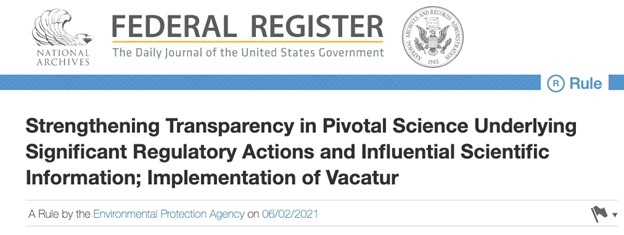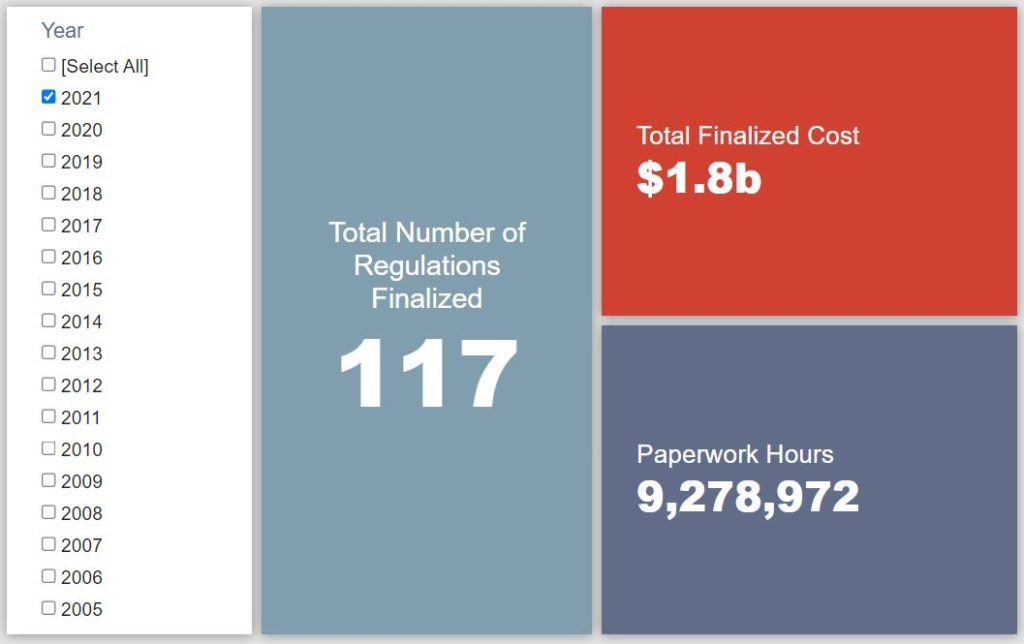Week in Regulation
June 7, 2021
Short Week Yields Little of Note
With only four days to work with due to the holiday weekend, last week was an unsurprisingly quiet one in terms of regulatory activity. How quiet was it? The most impactful action was a routine Federal Aviation Administration (FAA) “airworthiness directive” (AD). Across all rulemakings, agencies published roughly $19.4 million in total net costs and added 20,541 annual paperwork burden hours.
REGULATORY TOPLINES
- Proposed Rules: 32
- Final Rules: 54
- 2021 Total Pages: 30,081
- 2021 Final Rule Costs: $1.8 Billion
- 2021 Proposed Rule Costs: -$14 billion
NOTABLE REGULATORY ACTIONS
The most significant rulemaking in terms of estimated economic impact was this proposed AD regarding “Pratt & Whitney Turbofan Engines.” FAA estimates that it could cost covered operators roughly $11.5 million. No other rulemaking from the week had a quantified economic effect above $10 million.
CONGRESSIONAL REVIEW ACT UPDATE
On March 23, the first joint resolution of disapproval under the Congressional Review Act (CRA) of this term was introduced. CRA resolutions essentially seek to wholly rescind specific final rules within a set timeframe. The significance of these resolutions is discussed further here. In the interest of providing a public accounting of the potential economic impact of these actions should they pass, the American Action Forum (AAF) will provide a regular update of the rules being targeted and a concise summary of each rule’s purpose, economic impact, and why opponents may be targeting it.
TRACKING THE ADMINISTRATIONS
As we have already seen from executive orders and memos, the Biden Administration will surely provide plenty of contrasts with the Trump Administration on the regulatory front. And while there is a general expectation that the new administration will seek to broadly restore Obama-esque regulatory actions, there will also be areas where it charts its own course. Since the AAF RegRodeo data extend back to 2005, it is possible to provide weekly updates on how the top-level trends of President Biden’s regulatory record track with those of his two most recent predecessors. The following table provides the cumulative totals of final rules containing some quantified economic impact from each administration through this point in their respective terms.
![]()
Not only was this a pretty dull week for the Biden Administration, it appears that there is generally a post-Memorial Day weekend lull in past administrations as well. The Trump and Obama Administrations, respectively, had $82.1 million and $97.7 million in new costs in their commensurate weeks. In terms of paperwork, the Trump Administration saw no change and the Obama Administration saw a roughly 58,000-hour bump, thanks primarily to this Federal Communications Commission rule.
THIS WEEK’S REGULATORY PICTURE
This week, the Environmental Protection Agency (EPA) formally ends a Trump Administration rule on the agency’s use of scientific information.

On June 2, EPA published a final rule in the Federal Register that it was formally implementing a vacatur order against the “Strengthening Transparency in Pivotal Science Underlying Significant Regulatory Actions and Influential Scientific Information” rule issued by the Trump Administration in January. The new rule is the mechanism by which the regulatory text of the Trump Administration rule is removed from the Code of Federal Regulations.
The rule was one of the more controversial rules issued by EPA during the Trump Administration. The agency’s goal in issuing the rule was to set clear guidelines for how scientific information should be assessed in making regulatory decisions, with the aim of giving more emphasis to empirical data that could be reproduced to ensure the information’s accuracy.
As AAF explained in January, however, that simple goal was the subject of heated debate. The proposed rule generated more than 1 million comments in response. Supporters contended that it would bring needed clarity to the underlying data EPA bases its rulemaking activities upon, while opponents argued that the rule’s requirements would effectively impede EPA’s ability to address certain health and safety concerns, particularly studies on human health where privacy concerns prevent certain data from being released.
The rule was one of the main targets of President Biden’s Executive Order 13,990, which directed EPA to review several of the Trump Administration’s environmental actions. Before EPA could implement that order as it pertains to the science rule, however, the Biden Administration received a gift in the form of a court decision in a federal appeals court in Montana that vacated the rule.
That court determined that EPA improperly labeled the action a rule of internal agency procedure, which the agency used to justify making the rule immediately effective upon its publication in January. A federal district court ruled that the rule was substantive and therefore could not go into effect right away. A federal appeals court agreed, vacating the rule. That ruling allow the Biden Administration EPA to avoid going through the rulemaking process to rescind the rule.
TOTAL BURDENS
Since January 1, the federal government has published $12.2 billion in total net cost savings (with $1.8 billion in new costs from finalized rules) and 2.5 million hours of net annual paperwork burden reductions (with 9.3 million hours in increases from final rules).












